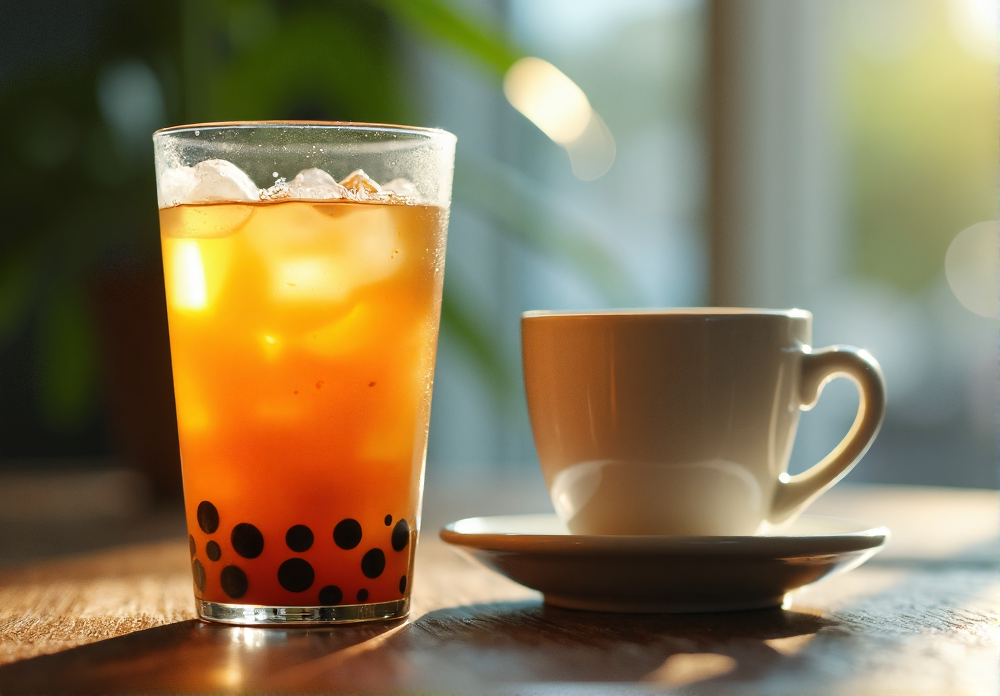Introduction: Bubble Tea vs. Coffee – A 2025 Health Guide
In the dynamic world of beverages, few contenders command the popularity of bubble tea and coffee. Each boasts a devoted following, drawn to their unique flavors, textures, and energizing properties. As health-conscious consumers increasingly scrutinize their dietary choices in 2025, understanding the nutritional implications of these beloved drinks is paramount. This comprehensive comparison serves as a guide, dissecting the caffeine content, sugar levels, calorie counts, and overall health effects of both bubble tea and coffee. Whether you’re a dedicated coffee aficionado or a bubble tea enthusiast, this article equips you with the knowledge to make informed decisions that align with your wellness goals. Coffee, a staple in many cultures, offers a stimulating caffeine boost and potential health benefits like improved cognitive function and antioxidant properties. However, variations in preparation, such as added sugars and creamers, can drastically alter its nutritional profile. Bubble tea, with its customizable flavors and playful tapioca pearls, presents a tempting indulgence. Yet, its often high sugar content and calorie density warrant careful consideration, especially for those mindful of their sugar intake. Navigating the beverage landscape requires a discerning approach, and this comparison provides the tools for making healthier choices in 2025. This detailed analysis explores the nuances of each beverage, examining their respective caffeine levels and their impact on energy, sleep, and overall well-being. We delve into the sugar content of both coffee and bubble tea, highlighting the potential risks of excessive sugar consumption, such as weight gain, metabolic issues, and dental problems. We’ll also compare the calorie content of various coffee preparations and bubble tea variations, empowering you to make choices that align with your individual calorie goals. Finally, we’ll provide expert nutritionist advice, offering valuable insights into the health impacts of regular consumption and emerging trends in 2025. This guide will help you understand the potential benefits and drawbacks of both beverages, enabling you to make informed choices that support your health and wellness journey. From the traditional black coffee to the latest bubble tea creations, we’ll cover the spectrum of options, offering a balanced perspective on these popular beverages. This comparative analysis goes beyond the surface, exploring the potential long-term health implications of regular coffee and bubble tea consumption. By understanding the nutritional profiles of these drinks, you can make informed choices that contribute to a healthier lifestyle in 2025 and beyond. This article provides practical tips for mitigating potential health risks associated with these beverages, such as opting for sugar-free alternatives, controlling portion sizes, and choosing healthier add-ins. By the end of this article, you’ll be well-equipped to navigate the world of bubble tea and coffee, making choices that align with your health and wellness priorities in 2025.
Caffeine Content: A Detailed Comparison
Caffeine, a natural stimulant, plays a significant role in both coffee and bubble tea, impacting energy levels and overall health. Its presence, however, differs considerably between these two beverages, influencing the physiological responses they elicit. Coffee, renowned for its invigorating kick, boasts varying caffeine concentrations depending on the bean type, roast, and brewing method. Lighter roasts typically hold higher caffeine levels compared to their darker counterparts, with an average 8-ounce cup of brewed coffee containing between 95 to 200 mg of caffeine. This can provide a substantial energy boost, making coffee a popular choice for those seeking increased alertness and focus. However, such high caffeine intake can also lead to adverse effects like anxiety, insomnia, and heart palpitations if consumed excessively, especially for individuals sensitive to stimulants. In contrast, bubble tea’s caffeine content stems primarily from its tea base, which can range from black and green to oolong and white tea varieties. Black tea, the most commonly used base, generally contains 40-70 mg of caffeine per serving, a considerably lower amount than coffee. Green tea offers a slightly milder caffeine presence. This difference in caffeine levels contributes to the gentler, less intense stimulating effect of bubble tea compared to coffee. The addition of milk, sweeteners, and toppings in bubble tea further dilutes the caffeine concentration, resulting in a more gradual and sustained energy lift rather than a sharp spike. However, it’s important to note that some bubble tea variations incorporate concentrated tea or even coffee, significantly boosting their caffeine content. Consumers should be mindful of these variations and choose according to their caffeine tolerance and health goals. For individuals seeking lower caffeine options, herbal or fruit-infused bubble teas without a tea base offer a refreshing alternative. Understanding the caffeine content of both coffee and bubble tea empowers consumers to make informed choices aligned with their health and lifestyle needs in 2025 and beyond. The 2025 health trends emphasize mindful consumption, and being aware of caffeine intake plays a crucial role in achieving overall wellness. Consulting a nutritionist or healthcare professional can provide personalized guidance on managing caffeine intake as part of a balanced diet and healthy lifestyle. They can help individuals determine the appropriate amount of caffeine based on individual factors such as age, health conditions, and sensitivity levels. Moreover, staying informed about the latest research and recommendations regarding caffeine consumption is essential for making healthy beverage choices. By understanding the nuances of caffeine content in both coffee and bubble tea, individuals can navigate the beverage landscape effectively and make choices that support their well-being. From a nutritional standpoint, choosing beverages with lower sugar and calorie content while monitoring caffeine intake are key considerations for maintaining a healthy lifestyle. This awareness becomes increasingly important as health trends in 2025 shift towards personalized nutrition and preventative healthcare. Therefore, understanding the caffeine content in coffee and bubble tea is not just about an energy boost but about making informed choices that contribute to long-term health and wellness.
Sugar Levels and Calorie Comparison
When comparing bubble tea and coffee, sugar content emerges as a pivotal factor in assessing their health impacts. While pure black coffee is naturally devoid of sugar, the landscape changes dramatically when considering the popular coffeehouse variations. These often come laden with added sugars in the form of syrups, flavored creamers, and sweeteners, significantly increasing their overall sugar load. A seemingly innocent flavored latte can harbor anywhere from 20 to 30 grams of sugar, a substantial contribution to one’s daily sugar intake, potentially exceeding recommended limits. Excessive sugar consumption is linked to various health concerns, including weight gain, type 2 diabetes, and heart disease, making it crucial for health-conscious consumers to be mindful of these hidden sugars. Bubble tea, on the other hand, has gained notoriety for its inherently high sugar content, largely stemming from the added syrups and the often-sweetened tapioca pearls. A standard serving can contain a staggering 30 to 50 grams of sugar, sometimes even more depending on the size and added ingredients. While some establishments offer reduced-sugar options, even these ‘less sweet’ versions can still contain a significant amount of sugar compared to unsweetened beverages. It’s essential for consumers to be aware of this and make informed choices. The calorie comparison between bubble tea and coffee further highlights the nutritional disparities. Plain black coffee boasts minimal calories, typically less than 5 per serving, making it a low-calorie beverage choice. However, the addition of sugar, milk, and flavorings can drastically increase the calorie count. A sugary latte, for instance, can range from 150 to 300 calories, depending on the size and ingredients. Bubble tea, with its combination of sugar, milk, and tapioca pearls, often surpasses 300 calories per serving, with some variations reaching upwards of 500 calories. These high calorie and sugar levels in bubble tea can contribute to weight gain and other health problems if consumed regularly, particularly if it replaces more nutrient-rich food choices in one’s diet. From a nutritional standpoint, the high sugar content in both beverages presents concerns, particularly regarding added sugars. The American Heart Association recommends limiting added sugar intake to no more than 25 grams per day for women and 36 grams per day for men. Regularly exceeding these limits can increase the risk of various health issues, including cardiovascular disease, metabolic syndrome, and fatty liver disease. Therefore, it’s crucial to consider the sugar content when choosing between these beverages and opt for healthier alternatives or modifications whenever possible. The impact of these beverages on blood sugar levels is another key consideration for health-conscious individuals, especially those with diabetes or insulin resistance. The rapid absorption of sugars in both coffee drinks and bubble tea can lead to spikes in blood sugar, potentially disrupting metabolic balance. Choosing unsweetened options, limiting portion sizes, and being mindful of added ingredients can help mitigate these effects. Furthermore, the nutritional value of these beverages differs significantly. While coffee provides antioxidants and certain micronutrients, bubble tea often lacks substantial nutritional benefits. Therefore, from a nutritional perspective, coffee, particularly in its unsweetened form, may offer a slight edge over bubble tea. In 2025, health-conscious consumers are increasingly seeking healthier beverage options, driving trends toward reduced-sugar variations and alternative ingredients in both coffee and bubble tea. This growing awareness of sugar content and its health implications is shaping consumer preferences and influencing the beverage industry’s innovations. Understanding the nutritional composition of both coffee and bubble tea empowers individuals to make informed choices that align with their health goals and overall well-being.
Nutritionist Advice: Health Impacts and 2025 Trends
From a nutritionist’s perspective, regular consumption of both bubble tea and coffee presents distinct health implications, particularly concerning overall wellness, nutritional balance, and beverage choices. Coffee, when enjoyed in moderation, can offer several health benefits, including improved cognitive function and a potentially reduced risk of type 2 diabetes, aligning with current research in nutritional science. These benefits are primarily associated with coffee’s antioxidant properties and its stimulating effect on the central nervous system. However, excessive caffeine intake can negatively impact health and wellness, leading to anxiety, insomnia, and heart palpitations. Therefore, moderation and mindful consumption are key to maximizing coffee’s potential health benefits. Bubble tea, a popular beverage choice, presents a different set of considerations from a nutritional standpoint. Due to its typically high sugar and calorie content, bubble tea poses a greater risk of weight gain, dental issues, and metabolic disorders, impacting both immediate and long-term health. The often limited nutritional value in standard bubble tea recipes, coupled with the high sugar content from added syrups and toppings, contributes to its classification as a less healthy choice compared to plain, unsweetened coffee. Choosing healthier customizations, such as reduced sugar options and natural sweeteners, can help mitigate some of these risks. A registered dietitian would advise consumers to be mindful of their intake of both beverages, especially sugary variations, prioritizing balanced nutrition and informed beverage choices. For coffee enthusiasts, opting for black coffee or using natural sweeteners like stevia or a small amount of honey is recommended to minimize added sugars and maximize potential health benefits. This approach aligns with 2025’s health and wellness trends, which emphasize natural ingredients and reduced sugar consumption. For bubble tea lovers, choosing lower sugar options, smaller serving sizes, and less frequent consumption are crucial for managing sugar intake and overall calorie consumption. Exploring alternative toppings like fresh fruit or opting for milk alternatives can also contribute to a more nutritionally balanced beverage. The beverage industry is responding to these trends by offering more customizable options, allowing consumers to tailor their drinks to their health and wellness goals. Consumers are increasingly aware of the health implications of their beverage choices and are actively seeking healthier alternatives and customizations, driving demand for lower-sugar options, natural ingredients, and functional add-ins. This shift in consumer behavior is influencing 2025 trends in the beverage sector, with cafes and bubble tea shops increasingly offering healthier options and greater transparency regarding ingredients and nutritional information. In addition to managing sugar and calorie intake, considering the nutritional profile of these beverages is essential. While coffee provides minimal calories and negligible sugar in its pure form, bubble tea’s nutritional value largely depends on its ingredients. Opting for nutrient-rich add-ins like chia seeds or incorporating a source of protein can enhance the nutritional value of bubble tea while aligning with the growing emphasis on functional beverages. Ultimately, informed choices and moderation are key to enjoying both coffee and bubble tea as part of a balanced and healthy lifestyle.
Conclusion: Making Healthier Choices
Navigating the beverage landscape in 2025 requires a discerning approach, especially when considering popular choices like bubble tea and coffee. Both offer unique flavor profiles and energizing effects, but their impact on health and well-being varies significantly. While both beverages can fit into a balanced lifestyle, informed choices are crucial for mitigating potential health risks and maximizing potential benefits. Coffee, in its purest form (black coffee), boasts a low-calorie count and offers potential health perks, including improved cognitive function and antioxidant benefits. However, the additions of syrups, sweeteners, and creamers, common in many specialty coffee drinks, can transform this relatively healthy beverage into a calorie-dense, sugar-laden treat, negating its inherent health benefits. For the health-conscious consumer, opting for black coffee or using minimal natural sweeteners like stevia or a splash of unsweetened almond milk can help maintain a healthy balance. Bubble tea, on the other hand, often presents a greater health challenge due to its typically high sugar content and calorie count. The customizable nature of bubble tea, with its various toppings and flavor options, often leads to a higher intake of added sugars and unhealthy fats. A single serving can quickly surpass recommended daily sugar limits, contributing to weight gain, insulin resistance, and other health concerns. To make healthier bubble tea choices, consider opting for smaller serving sizes, requesting less sugar, and choosing toppings like fresh fruit over tapioca pearls, which often add significant calories and carbohydrates. From a nutritional standpoint, moderation and informed decision-making are key to enjoying both beverages. Frequency of consumption plays a vital role in mitigating potential adverse effects. While daily black coffee consumption may offer certain health benefits, daily bubble tea consumption could pose significant risks due to the cumulative effects of high sugar and calorie intake. Listening to your body’s cues regarding caffeine tolerance is also essential. Excessive caffeine intake, whether from coffee or certain bubble tea varieties, can lead to anxiety, sleep disturbances, and other health issues. Caffeine content can vary significantly, influenced by factors like coffee bean type, roast level, and brewing method in coffee, and tea type and brewing strength in bubble tea. Consulting resources like the USDA Food Composition Databases or reputable health and nutrition websites can provide detailed information about caffeine content and nutritional values, empowering consumers to make informed choices aligned with their individual health goals. In 2025 and beyond, mindful consumption remains crucial. By understanding the nutritional profiles of both coffee and bubble tea, making conscious choices about ingredients and frequency, and listening to your body’s signals, you can enjoy these popular beverages as part of a balanced and healthy lifestyle.



